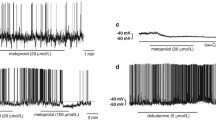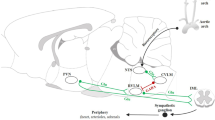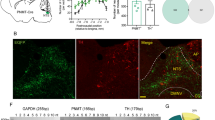Abstract
1. There is a general agreement concerning the key role of the baroreceptor reflex in blood pressure homeostasis. It is also well accepted that baroreceptor afferent messages are first integrated within the nucleus tractus solitarius (NTS) and that an excitatory amino acid, probably glutamate, is the principal neurotransmitter of corresponding afferents fibers. However, important points concerning the processing of baroreceptor messages within the NTS remain to be clarified, in particular the possible modulatory role of other neuroactive substances at this particular level in the medulla oblongata.
2. In this context, the present review focuses on serotonin, and the possible facilitatory influence of NTS serotonergic afferents and receptors on the baroreceptor reflex arc. Relevant pharmacological, electrophysiological, immunohistochemical, and biochemical data, are presented and discussed. They can be summarized as follows.
3. The selective destruction of the nodose ganglion-NTS serotonergic pathway produces a long-term increase in blood pressure variability, similar to that caused by baroreceptor denervation.
4. Microinjection of picomolar doses of 5-HT into the NTS elicits the typical responses of baroreceptor activation.
5. The cardiovascular effects elicited by local microinjections of specific agonists and antagonists into the NTS of intact rats and of animals that underwent nodose ganglionectomy indicate that the baroreceptor-like effects of locally administered 5-HT are mediated by the activation of postsynaptic 5-HT2 receptors.
6. The medullary pathways which mediate NTS 5-HT2 receptor-evoked responses are similar to those involved in the baroreceptor reflex arc.
7. Pharmacological and electrophysiological studies suggest that the cardiovascular effects of intra-NTS 5-HT involve the 5-HT2A receptor subtype expressed by NTS barosensitive neurons that receive polysynaptic vagal afferents.
8. Intra-NTS microinjection of a subthreshold dose of DOI, a 5-HT2 receptor agonist, which, on its own, does not produce any cardiovascular changes, significantly enhances the bradycardiac component of the baroreflex.
9. Altogether, the data summarized above show that, in the NTS, 5-HT acting at 5-HT2A receptors exerts a facilitatory influence on the baroreceptor reflex, especially on the cardiac component of this reflex.
10. Convergent pharmacological and electrophysiological data indicate that, in the NTS, functional interactions between NMDA- and 5-HT2A-receptors coexpressed by the same neurons probably underlie the facilitatory influence of 5-HT upon the baroreceptor reflex.
11. Under physiological conditions, the 5-HT2A receptor-mediated facilitatory modulation of the cardiovagal component of the baroreflex might be triggered by 5-HT released from nodose ganglion-NTS serotoninergic afferent neurons and/or for serotoninergic projections originating in raphe nuclei. The latter possibility might notably occur during recovery after physical exercise and/or during the “freezing” reaction in stressed animals.
Similar content being viewed by others
Author information
Authors and Affiliations
Corresponding author
Rights and permissions
About this article
Cite this article
Raul, L. Serotonin2 Receptors in the Nucleus Tractus Solitarius: Characterization and Role in the Baroreceptor Reflex Arc. Cell Mol Neurobiol 23, 709–726 (2003). https://doi.org/10.1023/A:1025096718559
Issue Date:
DOI: https://doi.org/10.1023/A:1025096718559




